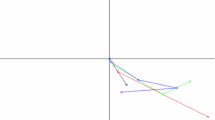Abstract
THE problem of random fragmentation of a line into a finite number of N parts has received considerable attention, partly because of its application in assessing the randomness of radioactive disintegrations and cosmic ray events. For a line of length l the average number of fragments equal to or greater than x is1:  This equation is readily applied to discuss2 an idealized case of random fragmentation of area. Consider a rectangle of sides l
1 and l
2 (area Σ = l
1
l
2) and imagine it to be divided into subrectangles by drawing at random N
1and N
2 lines respectively parallel to the two sides of the rectangle. If N(S) be the average number of elements of area equal to or exceeding S, we have, using equation (1):
This equation is readily applied to discuss2 an idealized case of random fragmentation of area. Consider a rectangle of sides l
1 and l
2 (area Σ = l
1
l
2) and imagine it to be divided into subrectangles by drawing at random N
1and N
2 lines respectively parallel to the two sides of the rectangle. If N(S) be the average number of elements of area equal to or exceeding S, we have, using equation (1):  where K
1(z) is the usual Bessel function of imaginary argument, N
0= N
1
N
2 is the total number of elements and S
0 the average area of an element,
where K
1(z) is the usual Bessel function of imaginary argument, N
0= N
1
N
2 is the total number of elements and S
0 the average area of an element,  For S≫S
0 we obtain the approximate relation:
For S≫S
0 we obtain the approximate relation: 
Similar content being viewed by others
References
Feller, W., Phys. Rev., 57, 906 (1940).
Goudsmit, S., Revs. Mod. Phys., 17, 321 (1945).
Author information
Authors and Affiliations
Rights and permissions
About this article
Cite this article
AULUCK, F., KOTHARI, D. Random Fragmentation. Nature 174, 565–566 (1954). https://doi.org/10.1038/174565a0
Issue Date:
DOI: https://doi.org/10.1038/174565a0
- Springer Nature Limited
This article is cited by
-
A study of the fragmentation of molecular clouds and the form of initial mass-function for low-mass protostellar fragments
Astrophysics and Space Science (1992)




